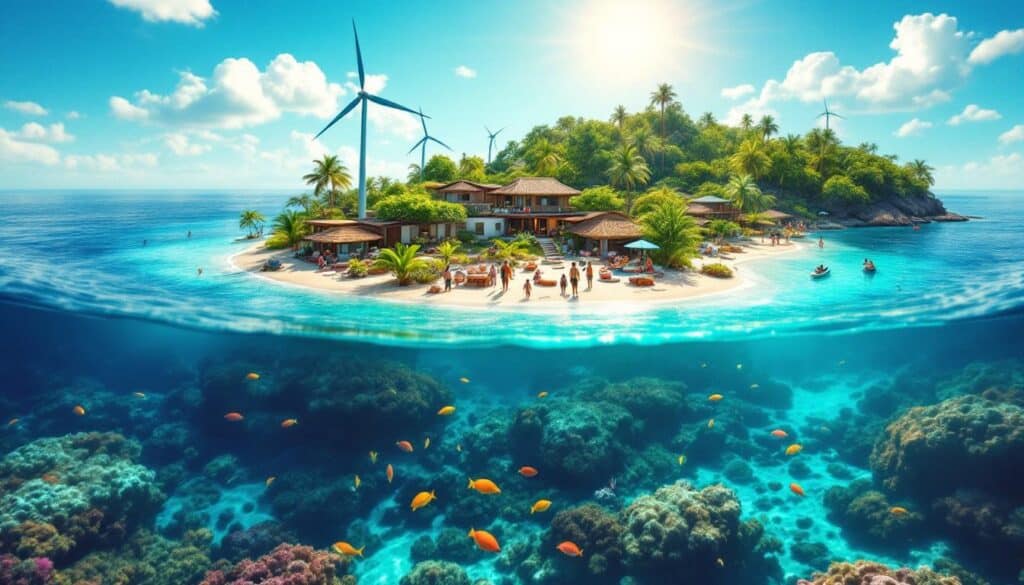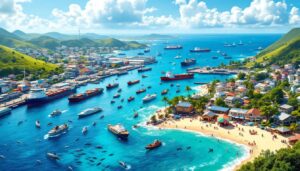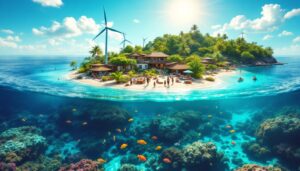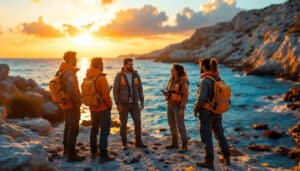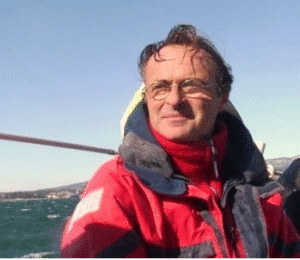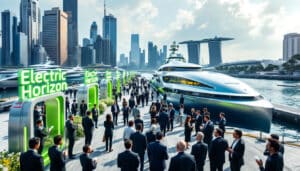In the heart of the Cook Islands, Manihiki embarks on an ambitious action plan. This initiative aims to restore the socio-economic fabric while rebalancing the marine resources and coral reef ecosystems. Through a multisectoral approach, various actors join forces to address the unique challenges of this isolated atoll.
This innovative project brings together the efforts of NGOs, the private sector, indigenous communities, and impact investors. The goal is to transform traditional sectors, such as the pearl industry, into sources of sustainable income. At the same time, coral reef conservation is at the heart of priorities, integrating scientific restoration and ecotourism initiatives. This holistic approach establishes a replicable model for other small island states in the Pacific.
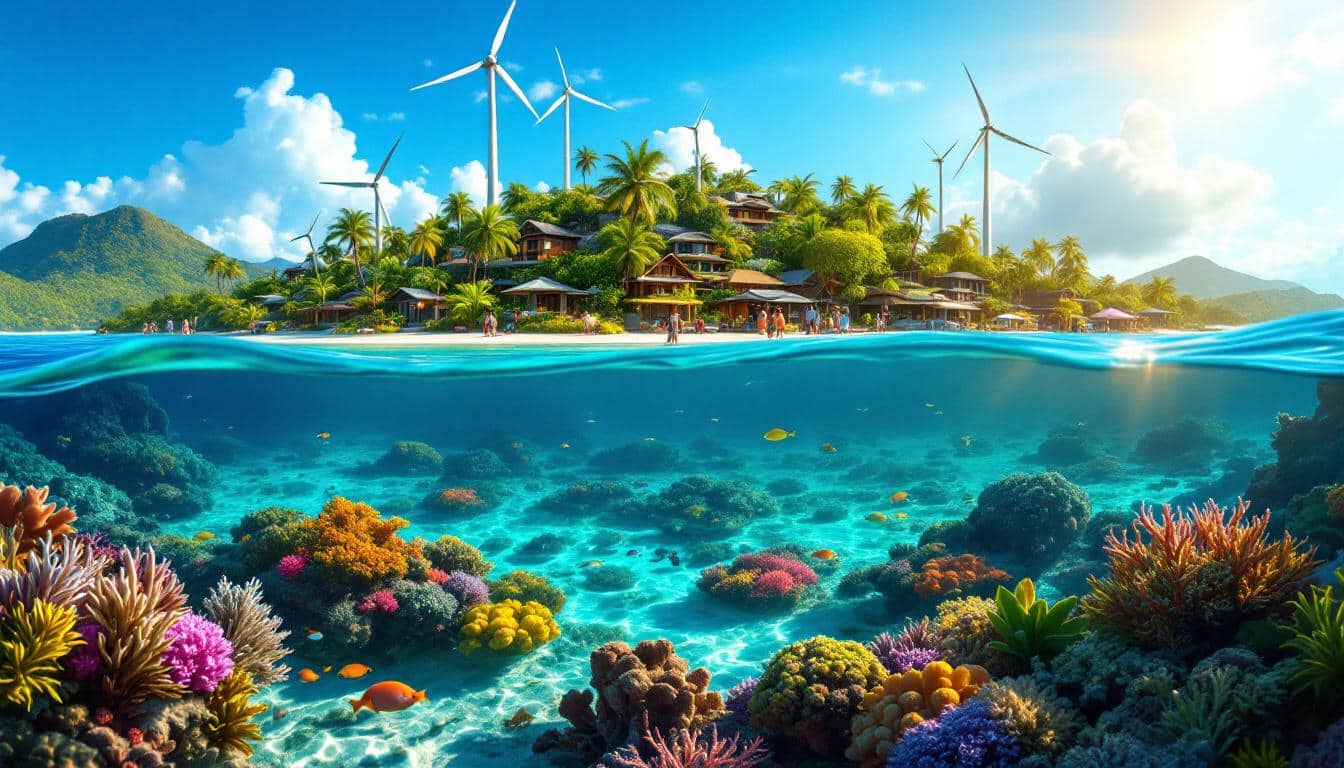
“`html
The remote island communities face unique challenges related to their geographic isolation, economic dependency, and environmental threats. The combination of a socio-economic redesign and coral reef preservation offers a promising pathway to enhance their resilience. This integrated approach not only restores essential marine ecosystems but also diversifies income sources and strengthens social cohesion.
Table of Contents
ToggleHow can a socio-economic redesign transform island communities?
A socio-economic redesign involves reorganizing economic and social structures to better meet the current and future needs of communities. In remote islands, this often means reducing dependence on vulnerable industries like intensive fishing or natural resource extraction. By diversifying income sources, such as ecotourism, sustainable mariculture, and renewable energies, the islands can create a more stable and resilient economy.
For example, the transformation of the pearl industry in Manihiki aims to replace a declining activity with sustainable initiatives based on ocean conservation. By integrating coral reef restoration projects, these communities can not only protect their marine environment but also develop profitable activities like ecological tourism and environmental education. This integrated socio-economic model is essential to ensure long-term improvements in living conditions and economic stability.
What role do coral reefs play in the resilience of islands?
Coral reefs are often regarded as the “guardians” of marine ecosystems. They protect coastlines from erosion, house rich biodiversity, and support local fisheries. Thus, the preservation and restoration of coral reefs are crucial for the resilience of island communities.
The establishment of marine protected areas and sustainable fishing practices helps to conserve biodiversity and ensure the long-term viability of fishery resources. Initiatives such as active coral restoration, including coral gardening and transplantation, enhance the capacity of reefs to withstand the impacts of climate change. Furthermore, reducing pollution and managing waste effectively contribute to maintaining the health of marine ecosystems.
What are the benefits of diversifying livelihoods?
Diversifying livelihoods is a key strategy for reducing the economic vulnerability of island communities. By promoting alternative activities such as ecotourism and sustainable mariculture, islands can create new sources of income and reduce their dependence on declining industries. This diversification also promotes economic and social equality by providing varied employment opportunities and encouraging local entrepreneurship.
Moreover, investing in training and education enables residents to acquire new skills and adapt to economic changes. Training programs in sustainable marine resource management, innovative agricultural techniques, and entrepreneurial development strengthen communities’ capacity to reinvent themselves and thrive in a constantly evolving environment.
How does local governance contribute to resilience?
Strengthened local governance is essential for the sustainable management of resources and social cohesion. By promoting community participation in decision-making, resource management, and conflict resolution, the islands can develop more effective and inclusive governance mechanisms.
Local governance structures can encourage accountability and transparency, thus facilitating equitable resource management and balanced development. For instance, marine management committees involving representatives from the community, NGOs, and the private sector can develop conservation plans tailored to local needs. This collaborative approach enhances resilience by ensuring that decisions made reflect the realities and aspirations of the residents.
How can access to markets be improved and fair trade promoted?
Improving market access is crucial for maximizing the economic benefits of local initiatives. By facilitating equitable access to markets for island products, communities can increase their revenues and invest more in sustainable development. Fair trade ensures that local producers receive fair compensation for their products, thereby fostering more inclusive economic growth.
Online trade platforms, partnerships with international distributors, and sustainability certifications can help island producers reach a broader market and enhance the value of their eco-friendly products. For example, initiatives like those described in Mariculture, a sustainable future for our oceans demonstrate how aquaculture partnerships can transform the future of sustainable fishing by integrating environmentally friendly practices with viable economic models.
What is the importance of coral reef conservation for marine biodiversity?
Coral reefs host an incredible diversity of marine life, including many endemic and endangered species. Therefore, the conservation of coral reefs is vital for maintaining marine biodiversity and the ecosystem services they provide, such as water filtration, storm protection, and providing essential habitats for fish and other marine organisms.
By protecting coral reefs, we also preserve the livelihoods of local communities that depend on these ecosystems for fishing and tourism. Initiatives like those orchestrated by Ocean Toa and Moshun.Earth demonstrate how collaboration between NGOs, the private sector, and indigenous communities can lead to effective restoration projects, ensuring the sustainability of reefs and local economies.
How do multi-sector partnerships strengthen resilience initiatives?
Multi-sector partnerships, involving NGOs, private companies, local communities, and impact investors, are essential for the success of resilience initiatives. By combining the resources, skills, and expertise of different actors, these partnerships create more comprehensive and sustainable solutions.
For example, the collaboration between Ocean Toa and Moshun.Earth has developed coral conservation projects integrated with economic initiatives, such as ecotourism and mariculture. These partnerships foster innovation and facilitate the transfer of advanced marine technologies, as illustrated by the progress of Carnegie Clean Energy in deploying wave energy in Europe.
What are the long-term impacts of socio-economic and environmental integration?
The integration of socio-economic developments with environmental preservation creates a synergy that can transform the future prospects of island communities. In the long term, this approach promotes sustainable economic growth, enhances resilience to environmental and social shocks, and improves the quality of life for residents.
By investing in coral reef restoration and diversifying income sources, islands can shield themselves from the devastating effects of climate change, such as rising sea levels and ocean acidification. Additionally, this integration fosters better management of natural resources, ensuring their availability for future generations. The successes observed in Manihiki can serve as a reproducible model for other small Pacific islands, illustrating how a holistic approach can lead to a more resilient and prosperous future.
What is the importance of education and capacity building?
Education and capacity building are essential pillars for ensuring the sustainability of resilience initiatives. By investing in vocational training and environmental education, island communities can develop the skills necessary to manage their natural resources effectively and adapt their economic practices.
Training programs in sustainable coral reef management, innovative agricultural techniques, and entrepreneurship enable residents to better understand the environmental and economic challenges they face. For instance, integrated educational initiatives may include workshops on sustainable fishing and hands-on training in mariculture, ensuring that the knowledge gained is directly applicable and beneficial to the community.
Furthermore, strengthening local capacities promotes autonomy and informed decision-making, which is crucial for the long-term management of resources and the effective implementation of resilience strategies. By equipping communities with the necessary tools to innovate and adapt, education plays a fundamental role in creating an environment conducive to sustainable development.
How can marine technologies support island resilience?
Marine technologies play a crucial role in monitoring, managing, and restoring marine ecosystems. Technological advancements such as aerial monitoring of coral reefs, the use of drones for marine mapping, and data-driven fishery management systems improve the efficiency and impact of conservation initiatives.
Moreover, renewable technologies, such as wave energy and offshore wind, offer sustainable solutions to meet the energy needs of island communities while reducing their carbon footprint. Innovative projects like those developed by a new offshore energy installation in Scotland demonstrate the potential of marine technologies to provide clean and reliable energy, contributing to the economic and environmental resilience of the islands.
By integrating these technologies into the socio-economic development plan, island communities can modernize their infrastructure, improve resource management, and enhance their capacity to face future challenges. The adoption of innovative technological solutions is therefore essential for building a sustainable and resilient future.
What criteria ensure the sustainability of initiatives?
To guarantee the sustainability of resilience initiatives, several criteria must be met. First, it is essential that projects are adapted to local contexts, considering the cultural, economic, and environmental specifics of island communities. A participatory approach, including residents in the design and implementation of projects, fosters ownership and the sustainability of initiatives.
Next, initiatives must be financially viable. This implies diversifying funding sources, ensuring transparent management of funds, and developing business models that generate sufficient revenues to sustain long-term activities. Strategic partnerships with the private sector, impact investors, and international organizations can provide the necessary resources to maintain and expand projects.
Finally, it is crucial to establish monitoring and evaluation mechanisms to assess progress made and adjust strategies accordingly. Clear indicators and regular reporting allow for the evaluation of the impact of actions taken and the identification of areas requiring improvement. This data-driven approach fosters proactive management and continuous adaptation to local and global changes.

